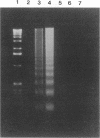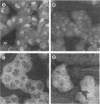Abstract
In previous studies, we observed that the virulent avian influenza A virus A/Turkey/Ontario/7732/66 (Ty/Ont) induced severe lymphoid depletion in vivo and rapidly killed an avian lymphocyte cell line (RP9) in vitro. In examining the mechanism of cell killing by this virus, we found that Ty/Ont induced fragmentation of the RP9 cellular DNA into a 200-bp ladder and caused ultrastructural changes characteristic of apoptotic cell death by 5 h after infection. We next determined that the ability to induce apoptosis was not unique to Ty/Ont. In fact, a variety of influenza A viruses (avian, equine, swine, and human), as well as human influenza B viruses, induced DNA fragmentation in a permissive mammalian cell line, Madin-Darby canine kidney (MDCK), and this correlated with the development of a cytopathic effect during viral infection. Since the proto-oncogene bcl-2 is a known inhibitor of apoptosis, we transfected MDCK cells with the human bcl-2 gene; these stably transfected cells (MDCKbcl-2) did not undergo DNA fragmentation after virus infection. In addition, cytotoxicity assays at 48 to 72 h after virus infection showed a high level of cell viability for MDCKbcl-2 compared with a markedly lower level of viability for MDCK cells. These studies indicate that influenza A and B viruses induce apoptosis in cell cultures; thus, apoptosis may represent a general mechanism of cell death in hosts infected with influenza viruses.
Full text
PDF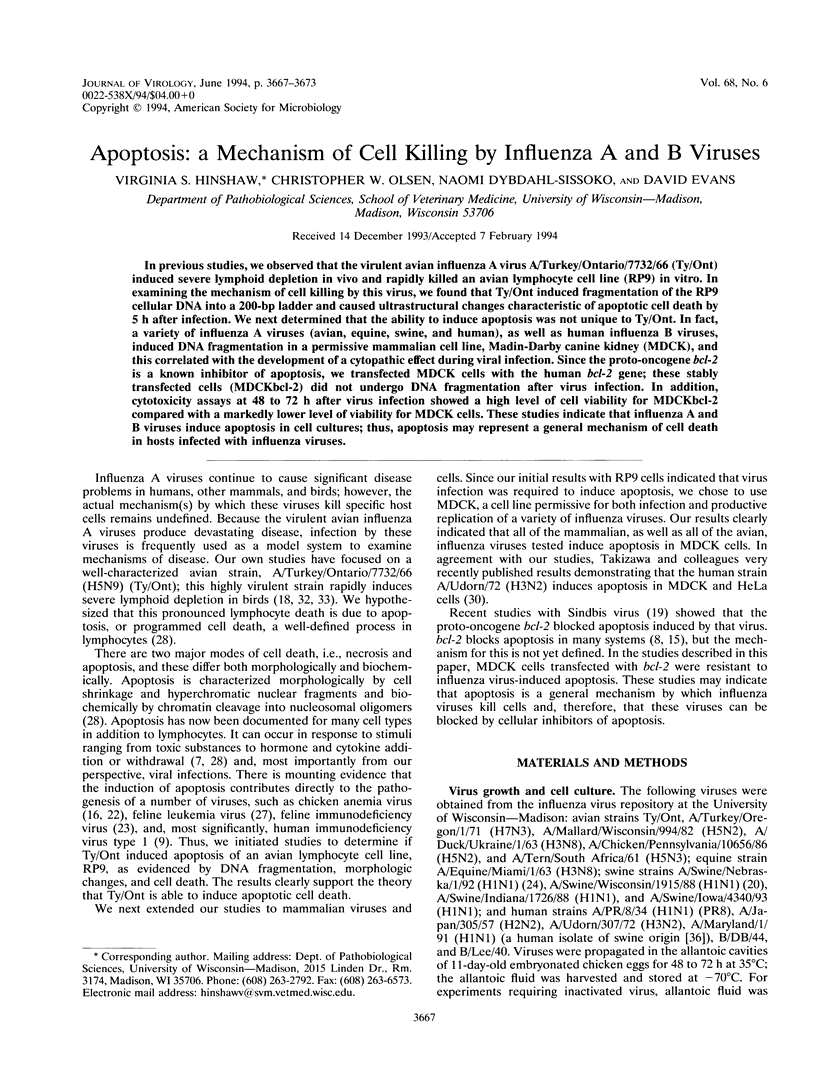
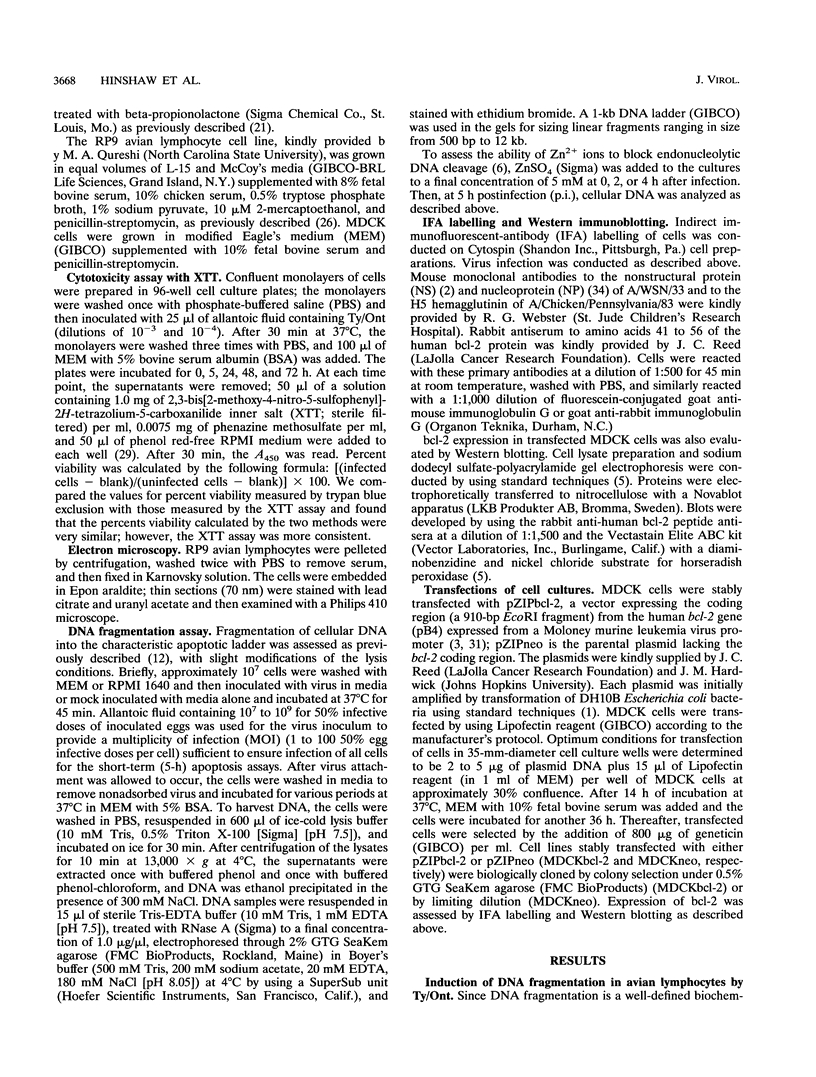
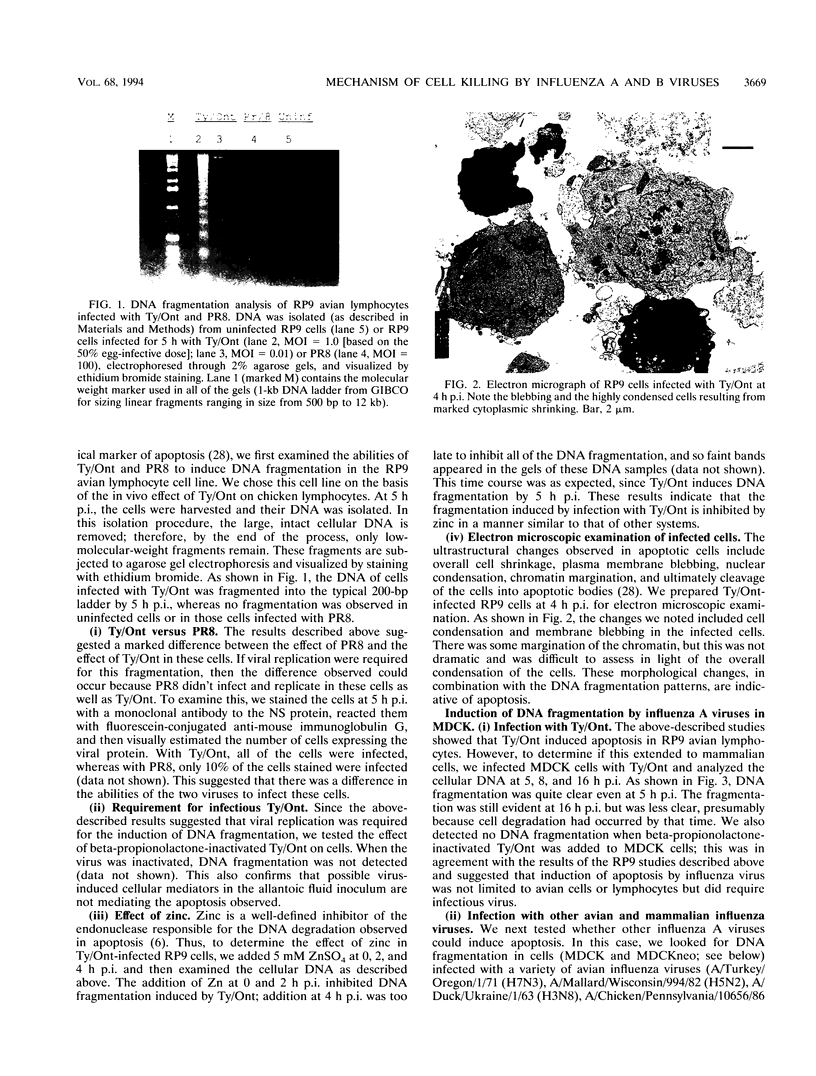
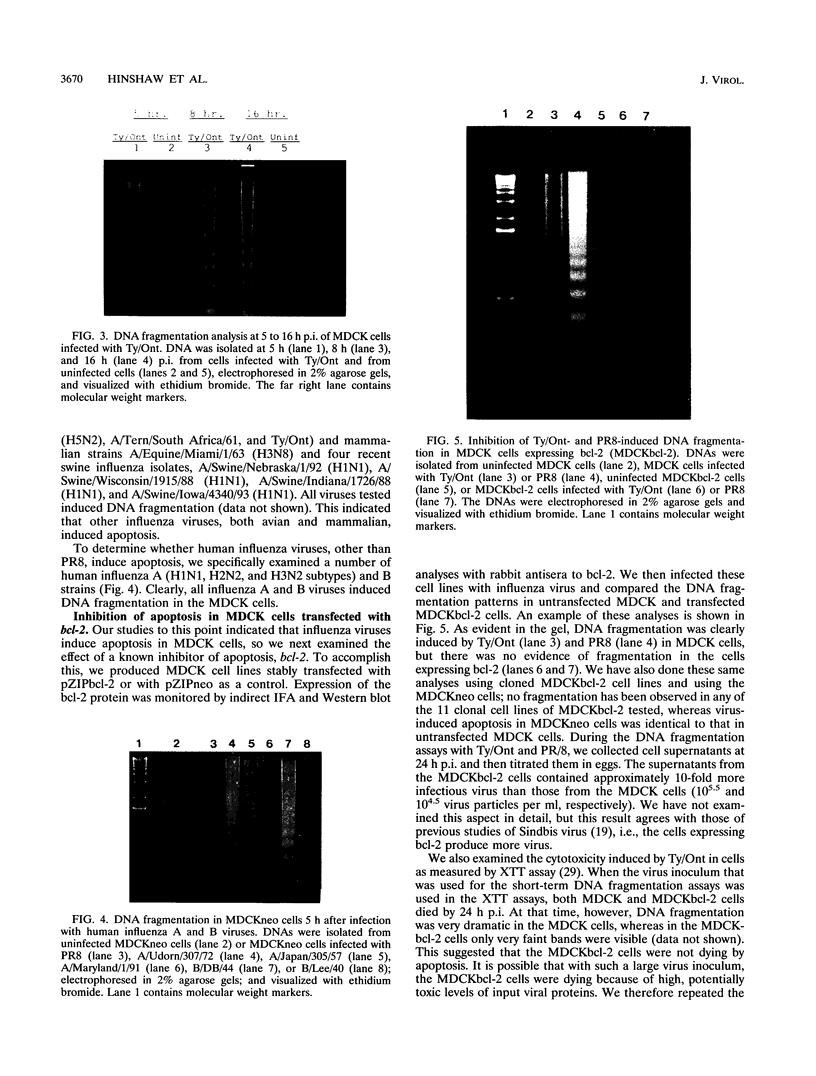
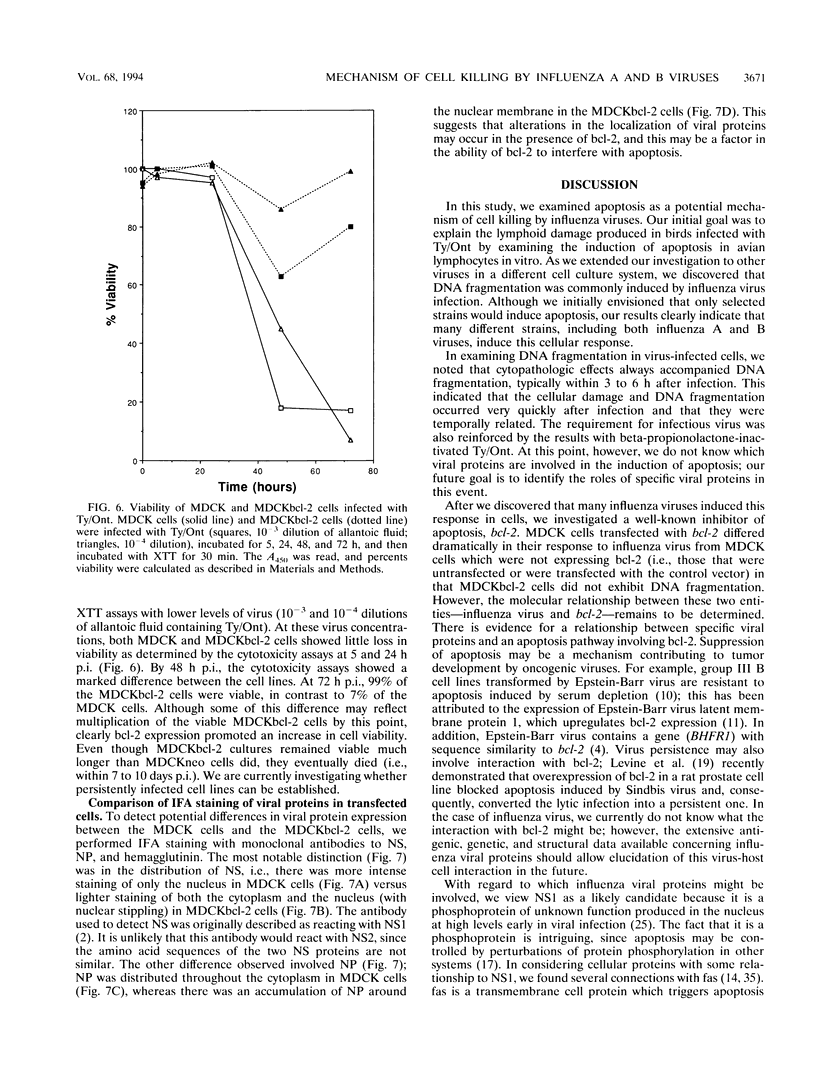
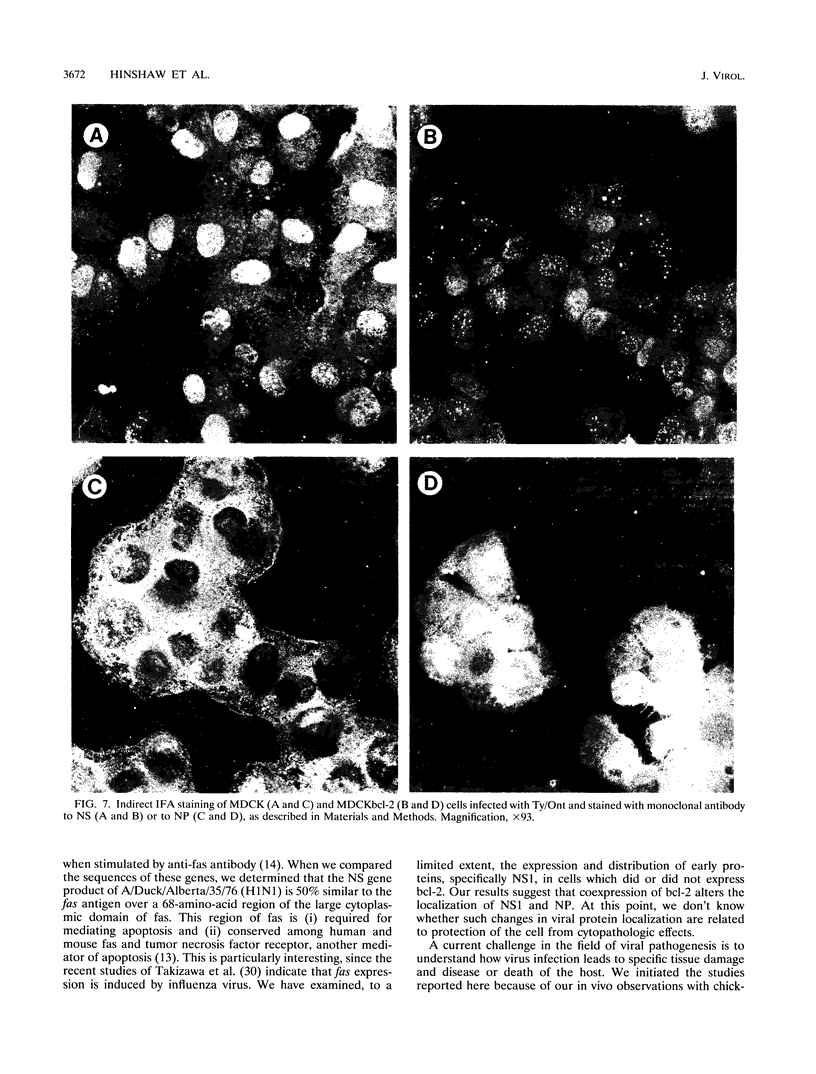
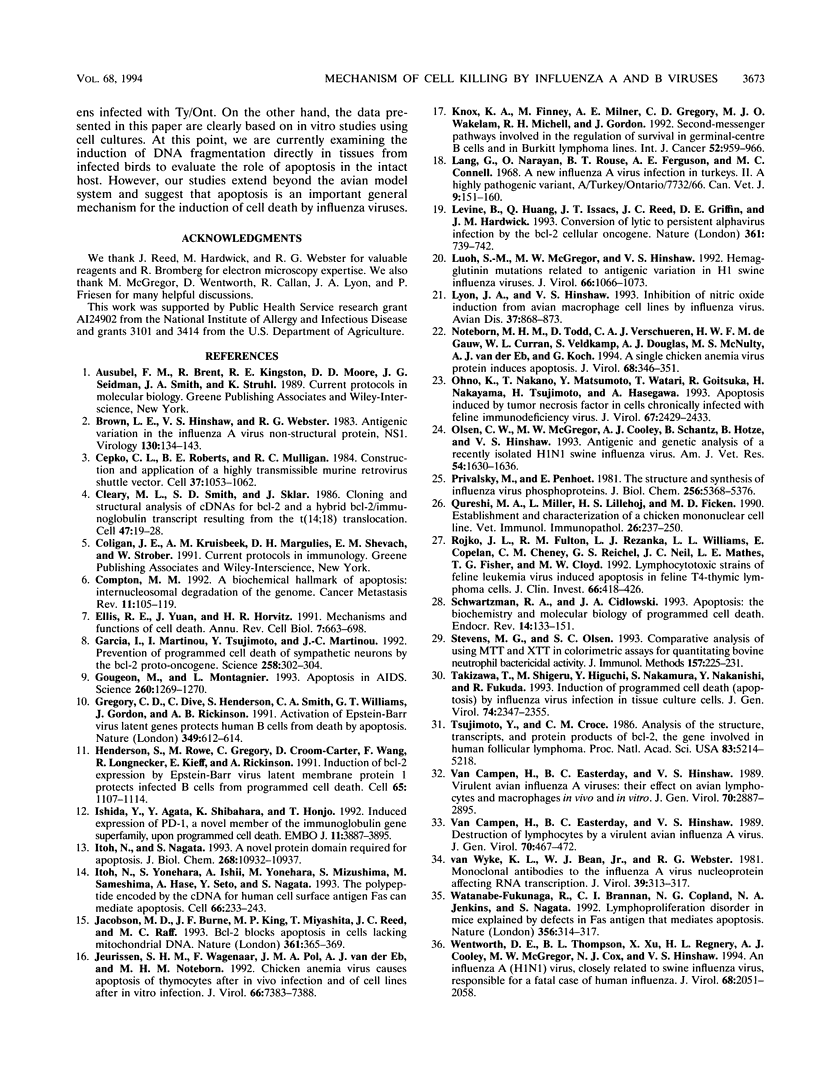
Images in this article
Selected References
These references are in PubMed. This may not be the complete list of references from this article.
- Brown L. E., Hinshaw V. S., Webster R. G. Antigenic variation in the influenza A virus nonstructural protein, NS1. Virology. 1983 Oct 15;130(1):134–143. doi: 10.1016/0042-6822(83)90123-x. [DOI] [PubMed] [Google Scholar]
- Cepko C. L., Roberts B. E., Mulligan R. C. Construction and applications of a highly transmissible murine retrovirus shuttle vector. Cell. 1984 Jul;37(3):1053–1062. doi: 10.1016/0092-8674(84)90440-9. [DOI] [PubMed] [Google Scholar]
- Cleary M. L., Smith S. D., Sklar J. Cloning and structural analysis of cDNAs for bcl-2 and a hybrid bcl-2/immunoglobulin transcript resulting from the t(14;18) translocation. Cell. 1986 Oct 10;47(1):19–28. doi: 10.1016/0092-8674(86)90362-4. [DOI] [PubMed] [Google Scholar]
- Compton M. M. A biochemical hallmark of apoptosis: internucleosomal degradation of the genome. Cancer Metastasis Rev. 1992 Sep;11(2):105–119. doi: 10.1007/BF00048058. [DOI] [PubMed] [Google Scholar]
- Ellis R. E., Yuan J. Y., Horvitz H. R. Mechanisms and functions of cell death. Annu Rev Cell Biol. 1991;7:663–698. doi: 10.1146/annurev.cb.07.110191.003311. [DOI] [PubMed] [Google Scholar]
- Garcia I., Martinou I., Tsujimoto Y., Martinou J. C. Prevention of programmed cell death of sympathetic neurons by the bcl-2 proto-oncogene. Science. 1992 Oct 9;258(5080):302–304. doi: 10.1126/science.1411528. [DOI] [PubMed] [Google Scholar]
- Gougeon M. L., Montagnier L. Apoptosis in AIDS. Science. 1993 May 28;260(5112):1269–1270. doi: 10.1126/science.8098552. [DOI] [PubMed] [Google Scholar]
- Gregory C. D., Dive C., Henderson S., Smith C. A., Williams G. T., Gordon J., Rickinson A. B. Activation of Epstein-Barr virus latent genes protects human B cells from death by apoptosis. Nature. 1991 Feb 14;349(6310):612–614. doi: 10.1038/349612a0. [DOI] [PubMed] [Google Scholar]
- Henderson S., Rowe M., Gregory C., Croom-Carter D., Wang F., Longnecker R., Kieff E., Rickinson A. Induction of bcl-2 expression by Epstein-Barr virus latent membrane protein 1 protects infected B cells from programmed cell death. Cell. 1991 Jun 28;65(7):1107–1115. doi: 10.1016/0092-8674(91)90007-l. [DOI] [PubMed] [Google Scholar]
- Ishida Y., Agata Y., Shibahara K., Honjo T. Induced expression of PD-1, a novel member of the immunoglobulin gene superfamily, upon programmed cell death. EMBO J. 1992 Nov;11(11):3887–3895. doi: 10.1002/j.1460-2075.1992.tb05481.x. [DOI] [PMC free article] [PubMed] [Google Scholar]
- Itoh N., Nagata S. A novel protein domain required for apoptosis. Mutational analysis of human Fas antigen. J Biol Chem. 1993 May 25;268(15):10932–10937. [PubMed] [Google Scholar]
- Itoh N., Yonehara S., Ishii A., Yonehara M., Mizushima S., Sameshima M., Hase A., Seto Y., Nagata S. The polypeptide encoded by the cDNA for human cell surface antigen Fas can mediate apoptosis. Cell. 1991 Jul 26;66(2):233–243. doi: 10.1016/0092-8674(91)90614-5. [DOI] [PubMed] [Google Scholar]
- Jacobson M. D., Burne J. F., King M. P., Miyashita T., Reed J. C., Raff M. C. Bcl-2 blocks apoptosis in cells lacking mitochondrial DNA. Nature. 1993 Jan 28;361(6410):365–369. doi: 10.1038/361365a0. [DOI] [PubMed] [Google Scholar]
- Jeurissen S. H., Wagenaar F., Pol J. M., van der Eb A. J., Noteborn M. H. Chicken anemia virus causes apoptosis of thymocytes after in vivo infection and of cell lines after in vitro infection. J Virol. 1992 Dec;66(12):7383–7388. doi: 10.1128/jvi.66.12.7383-7388.1992. [DOI] [PMC free article] [PubMed] [Google Scholar]
- Knox K. A., Finney M., Milner A. E., Gregory C. D., Wakelam M. J., Michell R. H., Gordon J. Second-messenger pathways involved in the regulation of survival in germinal-centre B cells and in Burkitt lymphoma lines. Int J Cancer. 1992 Dec 2;52(6):959–966. doi: 10.1002/ijc.2910520622. [DOI] [PubMed] [Google Scholar]
- Lang G., Narayan O., Rouse B. T., Ferguson A. E., Connell M. C. A new influenza A virus infection in turkeys II. A highly pathogenic variant, a/turkey/ontario 772/66. Can Vet J. 1968 Jul;9(7):151–160. [PMC free article] [PubMed] [Google Scholar]
- Levine B., Huang Q., Isaacs J. T., Reed J. C., Griffin D. E., Hardwick J. M. Conversion of lytic to persistent alphavirus infection by the bcl-2 cellular oncogene. Nature. 1993 Feb 25;361(6414):739–742. doi: 10.1038/361739a0. [DOI] [PubMed] [Google Scholar]
- Luoh S. M., McGregor M. W., Hinshaw V. S. Hemagglutinin mutations related to antigenic variation in H1 swine influenza viruses. J Virol. 1992 Feb;66(2):1066–1073. doi: 10.1128/jvi.66.2.1066-1073.1992. [DOI] [PMC free article] [PubMed] [Google Scholar]
- Lyon J. A., Hinshaw V. S. Inhibition of nitric oxide induction from avian macrophage cell lines by influenza virus. Avian Dis. 1993 Jul-Sep;37(3):868–873. [PubMed] [Google Scholar]
- Noteborn M. H., Todd D., Verschueren C. A., de Gauw H. W., Curran W. L., Veldkamp S., Douglas A. J., McNulty M. S., van der EB A. J., Koch G. A single chicken anemia virus protein induces apoptosis. J Virol. 1994 Jan;68(1):346–351. doi: 10.1128/jvi.68.1.346-351.1994. [DOI] [PMC free article] [PubMed] [Google Scholar]
- Ohno K., Nakano T., Matsumoto Y., Watari T., Goitsuka R., Nakayama H., Tsujimoto H., Hasegawa A. Apoptosis induced by tumor necrosis factor in cells chronically infected with feline immunodeficiency virus. J Virol. 1993 May;67(5):2429–2433. doi: 10.1128/jvi.67.5.2429-2433.1993. [DOI] [PMC free article] [PubMed] [Google Scholar]
- Olsen C. W., McGregor M. W., Cooley A. J., Schantz B., Hotze B., Hinshaw V. S. Antigenic and genetic analysis of a recently isolated H1N1 swine influenza virus. Am J Vet Res. 1993 Oct;54(10):1630–1636. [PubMed] [Google Scholar]
- Privalsky M. L., Penhoet E. E. The structure and synthesis of influenza virus phosphoproteins. J Biol Chem. 1981 Jun 10;256(11):5368–5376. [PubMed] [Google Scholar]
- Qureshi M. A., Miller L., Lillehoj H. S., Ficken M. D. Establishment and characterization of a chicken mononuclear cell line. Vet Immunol Immunopathol. 1990 Nov;26(3):237–250. doi: 10.1016/0165-2427(90)90094-9. [DOI] [PubMed] [Google Scholar]
- Rojko J. L., Fulton R. M., Rezanka L. J., Williams L. L., Copelan E., Cheney C. M., Reichel G. S., Neil J. C., Mathes L. E., Fisher T. G. Lymphocytotoxic strains of feline leukemia virus induce apoptosis in feline T4-thymic lymphoma cells. Lab Invest. 1992 Apr;66(4):418–426. [PubMed] [Google Scholar]
- Schwartzman R. A., Cidlowski J. A. Apoptosis: the biochemistry and molecular biology of programmed cell death. Endocr Rev. 1993 Apr;14(2):133–151. doi: 10.1210/edrv-14-2-133. [DOI] [PubMed] [Google Scholar]
- Stevens M. G., Olsen S. C. Comparative analysis of using MTT and XTT in colorimetric assays for quantitating bovine neutrophil bactericidal activity. J Immunol Methods. 1993 Jan 4;157(1-2):225–231. doi: 10.1016/0022-1759(93)90091-k. [DOI] [PubMed] [Google Scholar]
- Takizawa T., Matsukawa S., Higuchi Y., Nakamura S., Nakanishi Y., Fukuda R. Induction of programmed cell death (apoptosis) by influenza virus infection in tissue culture cells. J Gen Virol. 1993 Nov;74(Pt 11):2347–2355. doi: 10.1099/0022-1317-74-11-2347. [DOI] [PubMed] [Google Scholar]
- Tsujimoto Y., Croce C. M. Analysis of the structure, transcripts, and protein products of bcl-2, the gene involved in human follicular lymphoma. Proc Natl Acad Sci U S A. 1986 Jul;83(14):5214–5218. doi: 10.1073/pnas.83.14.5214. [DOI] [PMC free article] [PubMed] [Google Scholar]
- Van Campen H., Easterday B. C., Hinshaw V. S. Destruction of lymphocytes by a virulent avian influenza A virus. J Gen Virol. 1989 Feb;70(Pt 2):467–472. doi: 10.1099/0022-1317-70-2-467. [DOI] [PubMed] [Google Scholar]
- Van Campen H., Easterday B. C., Hinshaw V. S. Virulent avian influenza A viruses: their effect on avian lymphocytes and macrophages in vivo and in vitro. J Gen Virol. 1989 Nov;70(Pt 11):2887–2895. doi: 10.1099/0022-1317-70-11-2887. [DOI] [PubMed] [Google Scholar]
- Watanabe-Fukunaga R., Brannan C. I., Copeland N. G., Jenkins N. A., Nagata S. Lymphoproliferation disorder in mice explained by defects in Fas antigen that mediates apoptosis. Nature. 1992 Mar 26;356(6367):314–317. doi: 10.1038/356314a0. [DOI] [PubMed] [Google Scholar]
- Wentworth D. E., Thompson B. L., Xu X., Regnery H. L., Cooley A. J., McGregor M. W., Cox N. J., Hinshaw V. S. An influenza A (H1N1) virus, closely related to swine influenza virus, responsible for a fatal case of human influenza. J Virol. 1994 Apr;68(4):2051–2058. doi: 10.1128/jvi.68.4.2051-2058.1994. [DOI] [PMC free article] [PubMed] [Google Scholar]
- van Wyke K. L., Bean W. J., Jr, Webster R. G. Monoclonal antibodies to the influenza A virus nucleoprotein affecting RNA transcription. J Virol. 1981 Jul;39(1):313–317. doi: 10.1128/jvi.39.1.313-317.1981. [DOI] [PMC free article] [PubMed] [Google Scholar]





